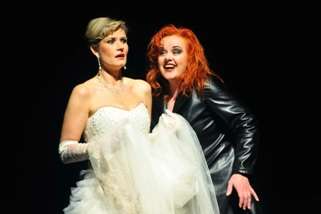|
Back
Bayreuth on the Danube Budapest
Palace of the Arts
06/09/2011 - & June 12, 18, 2011
Richard Wagner: Lohengrin
Michael Nagy (Royal Herald), Alfred Muff (King Heinrich), Béla Perencz (Telramund), Petra Lang (Ortrud), Camilla Nylund (Elsa), Istvan Kovácsházi (Lohengrin)
Honvéd Male Choir, Budapest Studio Choir, Hungarian Radio Choir, Hungarian State Opera Orchestra, Adám Fischer (conductor)
László Marton (production), Eva Duda (choreography)

C. Nylund & P. Lang (Courtesy of HSO)
Six years ago Hungary’s leading conductor Adám Fischer devised the bold new idea of presenting Wagner’s operas in a non-traditional venue, the Palace of the Arts. Less than ideally located in a southern industrial district of Budapest, its concrete and glass modernism is nevertheless graced within by the beautifully built Béla Bartók concert hall. The hall is a state of the art venue with acoustics that one is tempted to describe as perfect. For Wagner, its striking advantages add dimensions unfamiliar to listeners in traditional opera houses. The annual festival, held in June, adapts the stage in either full or partial formats (“mostly staged” might be the best description) to present full operas. The Bayreuth atmosphere is suggested by midafternoon start times and intermissions long enough to allow for serious contemplation and promenades in the nearby Danubian park surroundings. Just as at the Ur-Wagner Festival, brass players are dispatched from the orchestra to announce each new act with a rousing leitmotif. Previous years have featured a complete Ring, along with other works.
This year’s festival introduces Lohengrin in an imaginative production by László Marton. The opera emerges in a recent Central European past. King Heinrich is attended by vassals dressed in what could be either communist or fascist uniforms (no tell insignia), while Telramund and his men sport field greatcoats suitable to any European army in World War II. The ladies are at first dowdily dressed in modest 1940s styles, though Elsa, who makes her entrance from the audience, is somewhat more elegant. When Lohengrin triumphs over Telramund in his defense of Elsa’s virtue, however, these drab styles disappear in favor of warm colored dress shirts beneath. Nothing less than a hero’s victory is what the society needs to break out of its staid conventions and enter something that looks more contemporary in aesthetic sensibility. Indeed, throughout the opera Lohengrin looks very Bohemian in an artsy vest and polka dot ascot. He carries the sword, horn, and ring that he leaves for the restored Gottfried in an instrument case. Telramund’s ruin in the second act is depicted with his reduction to the castaway clothes of the urban down and out, while Ortrud’s dowdy wardrobe is ditched for a leather jacket. After the first act the action unfolds in a carefully scripted post-modernity. Usually it is a success. The swan is suggested by mirrors turned inward. Perhaps we are to feel that life’s decisive journeys, like Lohengrin’s mission of divine mercy, are inherently introspective. Suited private security guards helped by bomb-smelling dogs (German shepherds, of course) screen the Act II wedding guests and scan the Act III wedding nest. We seem meant to believe that no precaution can break the spell of Ortrud’s evil insinuations in dooming the fairy tale romance.
If Bayreuth traditions are replicated in this musical palace on the Danube, leading Wagnerian singers are not at all out of place. Camilla Nylund maintains an exhausting schedule of performances in the early, lighter Wagner soprano roles. Her Elsa was a continuing demonstration of how different these earlier roles are from Isolde and Brünnhilde and how they radiate their own unique beauty when intelligently sung. Petra Lang’s Ortrud exuded a fine mezzo tonality that only at times migrated into the shrill realm that ensnares too many talents. After admirable second act singing, Ortrud’s Act III hysterics descended into an unbalanced series of shrieks topped off by a blood curdling scream when Gottfried returns. Lang’s dramatic abilities, however, reflected the character’s evil with convincing verve and an insightfully overt sexuality that we rarely see in the role. The respectable bass of Alfred Muff brought much dignity to King Heinrich. On only a few occasions did he sound a bit wan. The original cast was to have included the highly regarded tenor Burkhard Fritz in the title role, but he was replaced by a revelation in the young Hungarian tenor Istvan Kovacshazi. Unknown to international audiences, Kovácsházi sang the role with a lightness of tone that the earlier Wagner tenor parts need and deserve. The characterization might have been a bit too delicate at times – who doesn’t want a heroic Lohengrin? – but it neither lacked expressive power nor conflicted with the overall concept. Béla Perencz’s Telramund brought another fine Hungarian singer to well-deserved attention. The impressive combined efforts of the Honvéd Male Choir, the Budapest Studio Choir, and the Hungarian Radio Choir delivered a spectacular choral performance.
Fischer’s superb conducting imbued the score with a laser-like precision. His recent resignation from the artistic directorship of the Hungarian State Opera over political disagreements with Hungary’s new right-wing government has not tarnished his artistic reputation. The audience’s wild cheering belied any notion that this Wagner Festival – perhaps the only regular event of its type outside Germany – will continue to be anything less than successful. It is only a pity that the 4pm start time on a weekday prevented a larger audience from attending. Such a worthy premiere should not have had so many empty seats. Well cast performances of Tristan und Isolde and Parsifal will follow.
Hungarian State Opera
Paul du Quenoy
|